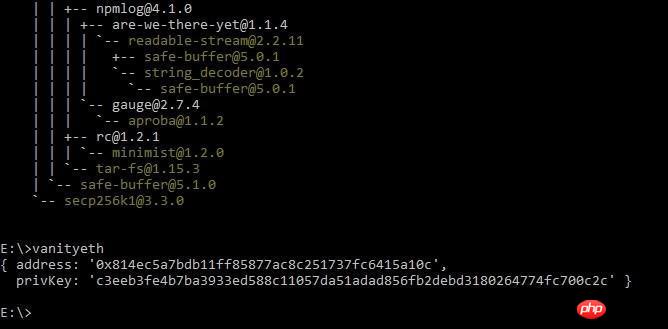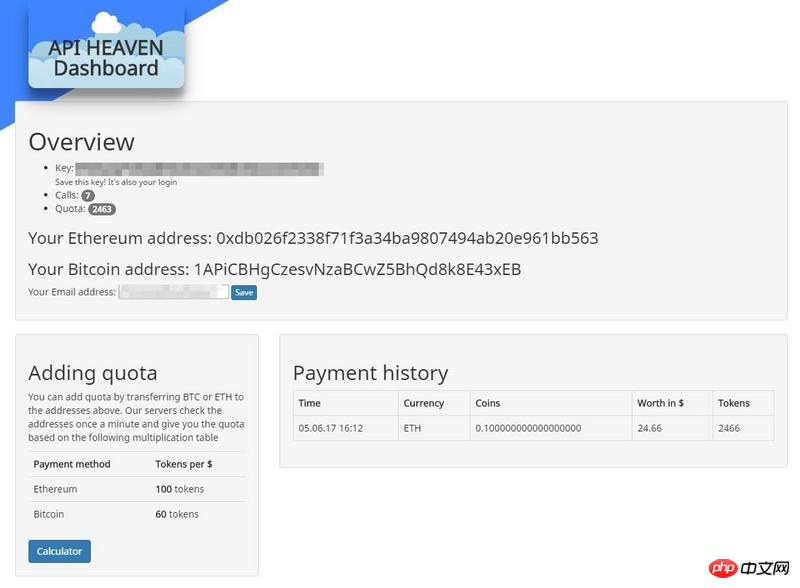How to use php to develop the payment system of Ethereum
This article is about PHP development of Ethereum system. It mainly introduces the use of PHP for smart contract development and interaction, account creation, transactions, transfers, token development, filters and events, etc.
When I first considered implementing payments via cryptocurrency, I looked at available solutions like Stripe. I think the problem with Stripe is that it only allows Bitcoin payments with US merchant accounts, so that's not an option for me. In the Ethereum world, it looks even worse. There are some newer services but they all want to share the cake.
So what do we need to build an Ethereum payment system from scratch?
A web server running PHP.
Have at least one Parity node in the private network with RPC enabled.
Virtual address generator on a network server, such as vanity-eth.
So how does it work?
Calculate the price of ETH using the current price from coinbase or kraken API.
Use a dummy generator to generate address pairs and encrypt or transfer the private key to another server.
Display the generated address to the customer and check the address every few seconds if payment is received.
Theoretically it seems to be no problem, so let's build it.
Step 1: Set up the server
We will use vanity-eth in nodejs to generate the address.
npm install -g vanity-eth@1.0.4"
After installing vanity-eth on Windows:

Also requires some Etherum nodes. I'm using Parity because it's fast and reliable.
Start it with these parameters, but do not expose the nodes directly to the Internet, keep them behind the firewall without port forwarding.
parity --jsonrpc-interface 0.0.0.0 --jsonrpc-hosts="all" --auto-update=all --jsonrpc-cors null
Parity log of completed synchronization:

For faster deployment, you can use Parity Docker containers. Data can also be saved so that you don't have to resynchronize each time the container is remade.
Step 2: Write the payment class
First create a folder called libs and clone the php-ethereum repo into it. The ethereum-php project is a good wrapper for the json-rpc class.
Then we use the following class and save it as ethpay.php. This is the main logic of payment processing. You can use this to:
Generate address pairs
Check balances (pending and completed)
Convert from WEI to ETH
<?php
define('RPC_IP','127.0.0.1');
define('RPC_PORT',8545);
require 'libs/ethereum-php/ethereum.php';
$e = new EthPay();
class EthPay
{
private $eth;
//让我们建立与parity节点的连接
function __construct()
{
$this->eth = new Ethereum(RPC_IP, RPC_PORT);
if(!$this->eth->net_version()) die('RPC ERROR');
}
/ *
*得到一个地址的余额,
*来自parity的余额以十六进制形式出现在wei中
*使用bc数学函数转换它
* /
function getBalanceOfAddress($addr)
{
$eth_hex = $this->eth->eth_getBalance($addr, 'latest');
$eth = $this->wei2eth($this->bchexdec($eth_hex));
$pending_hex = $this->eth->eth_getBalance($addr, 'pending');
$pending = $this->wei2eth($this->bchexdec($pending_hex));
return array('balance'=>$eth,'pending'=>$pending);
}
function getCurrentPrice($currency='USD')
{
$data = json_decode(file_get_contents('https://api.coinbase.com/v2/prices/ETH-'.$currency.'/spot'),true);
return $data['data']['amount'];
}
/*
*我们将使用vanityeth生成私钥对
* npm install -g vanity-eth
*我们必须重新格式化输出字符串以用作JSON
* /
function genPair()
{
exec('vanityeth', $outputAndErrors, $return_value);
$answer = implode(NULL,$outputAndErrors);
$answer = str_replace('address:','"address":',$answer);
$answer = str_replace('privKey:','"privKey":',$answer);
$answer = str_replace('\'','"',$answer);
return json_decode($answer,true);
}
//以下功能用于转换和处理大数字
function wei2eth($wei)
{
return bcp($wei,1000000000000000000,18);
}
function bchexdec($hex) {
if(strlen($hex) == 1) {
return hexdec($hex);
} else {
$remain = substr($hex, 0, -1);
$last = substr($hex, -1);
return bcadd(bcmul(16, $this->bchexdec($remain)), hexdec($last));
}
}
}Final Step: Integrate with Your Website
There are multiple ways to do this depending on your service .
At API Heaven, we provide each customer with an ETH address where funds can be deposited. The cronjob checks all customer addresses every minute to detect changes. If they add ETH to the address, the balance is converted into API quota, so our customers don't even need to log into the site to add funds.
Sample integration in API Heaven:

Another approach is to calculate a fixed price and save it in the user session. The customer has to pay on the website and you need to AJAX to query the payment received. If the full amount is received, the backend triggers the sale.
Best of all, you don’t need an external service to integrate the Ethereum payment system on your website. Come and learn and play Ethereum together.
Related recommendations:
How to develop an online payment system with PHP
How to develop a virtual domain name system
The above is the detailed content of How to use php to develop the payment system of Ethereum. For more information, please follow other related articles on the PHP Chinese website!

Hot AI Tools

Undresser.AI Undress
AI-powered app for creating realistic nude photos

AI Clothes Remover
Online AI tool for removing clothes from photos.

Undress AI Tool
Undress images for free

Clothoff.io
AI clothes remover

Video Face Swap
Swap faces in any video effortlessly with our completely free AI face swap tool!

Hot Article

Hot Tools

Notepad++7.3.1
Easy-to-use and free code editor

SublimeText3 Chinese version
Chinese version, very easy to use

Zend Studio 13.0.1
Powerful PHP integrated development environment

Dreamweaver CS6
Visual web development tools

SublimeText3 Mac version
God-level code editing software (SublimeText3)

Hot Topics
 1387
1387
 52
52
 What is Ouyi for? What is Ouyi
Apr 01, 2025 pm 03:18 PM
What is Ouyi for? What is Ouyi
Apr 01, 2025 pm 03:18 PM
OKX is a global digital asset trading platform. Its main functions include: 1. Buying and selling digital assets (spot trading), 2. Trading between digital assets, 3. Providing market conditions and data, 4. Providing diversified trading products (such as derivatives), 5. Providing asset value-added services, 6. Convenient asset management.
 How to withdraw Ouyi okex currency?
Mar 31, 2025 pm 09:33 PM
How to withdraw Ouyi okex currency?
Mar 31, 2025 pm 09:33 PM
This article introduces in detail the steps and preparations for withdrawing OKX digital currency. First of all, it is necessary to ensure that account registration, real-name authentication has been completed, and sufficient withdrawal balance has been established. Secondly, be sure to prepare an accurate external storage address. The article then gradually explained the operation steps such as logging in to the account, entering the withdrawal page, selecting currency, filling in withdrawal information (including address, quantity, handling fee), confirming withdrawal and viewing withdrawal records, and emphasized the necessity of checking the information to avoid asset losses.
 What are the commonly used transactions in April 2025
Mar 31, 2025 pm 10:06 PM
What are the commonly used transactions in April 2025
Mar 31, 2025 pm 10:06 PM
The most popular digital asset exchanges in April 2025 include Binance, Ouyi, Bitget, Sesame Open Door, Bybit and Coinbase Pro. 1) Binance is known for its high liquidity and rich trading pairs; 2) Ouyi attracts Chinese investors with its security and diverse services; 3) Bitget is suitable for professional derivatives traders; 4) Sesame door opening is suitable for medium- and long-term investors, etc.
 A list of ten promising digital currency trading software recommendation websites
Mar 31, 2025 pm 06:45 PM
A list of ten promising digital currency trading software recommendation websites
Mar 31, 2025 pm 06:45 PM
This article recommends several promising digital currency trading software, including Binance, Ouyi OKX, Gate.io Sesame Open Door, Huobi HTX, Bitget, Kraken, Gemini, Bybit, Coinbase and KuCoin. These platforms have been established at different times and are headquartered all over the world. They provide a variety of services such as spot trading, contract trading, derivative trading, etc., and have different features and advantages, such as Binance's ease of use, Ouyi's trading volume, Gate.io's product variety, and Coinbase's beginner-friendly, etc. Users can choose the right platform to conduct digital currency transactions according to their own needs. Choose a formal platform and pay attention to risks
 Currency trading platform rankings Top 10 recommended virtual currency trading mobile apps
Mar 31, 2025 pm 09:27 PM
Currency trading platform rankings Top 10 recommended virtual currency trading mobile apps
Mar 31, 2025 pm 09:27 PM
This article introduces the top ten mainstream virtual currency exchanges in the world, including Binance, OKX, Gate.io, Huobi, Coinbase, KuCoin, Kraken, Bitfinex, Gemini and Bybit. These exchanges have their own characteristics. Binance leads the world with its high trading speed and trading volume. OKX and Bybit focus on derivatives trading, Gate.io and KuCoin are known for their rich trading pairs and low fees. Coinbase and Gemini focus more on user experience and security. Huobi is leading the way in the Asian market, while Kraken and Bitfinex are more popular among professional traders. Choose the right one
 xbit official website login entrance xbit exchange official website login entrance home page
Mar 31, 2025 pm 08:30 PM
xbit official website login entrance xbit exchange official website login entrance home page
Mar 31, 2025 pm 08:30 PM
XBIT is a decentralized cryptocurrency exchange (DEX) focusing on Meme currency trading. Its core advantage lies in integrating multi-chain protocols and zero-knowledge proof technology, supporting cross-chain transactions of mainstream public chain assets such as Ethereum, BNB Chain, and Solana, and achieving millisecond-level transaction confirmation and low Gas fees through the Layer2 expansion solution. The platform gathers more than 200 popular Meme coins, provides rich trading pairs and liquidity mining, and pays attention to user privacy protection, so that transactions can be conducted without forced KYC. In addition, XBIT has passed the EU MiCA compliance review and actively expanded the global market, supported fiat currency to cryptocurrencies, and is committed to becoming a safe, efficient, privacy-friendly global DEX platform.
 Ranking of the Currency Circle Futures Trading APP Recommended by the Top Ten Futures Trading Platforms in Currency Circle
Mar 31, 2025 pm 04:57 PM
Ranking of the Currency Circle Futures Trading APP Recommended by the Top Ten Futures Trading Platforms in Currency Circle
Mar 31, 2025 pm 04:57 PM
This article recommends the top ten futures trading platforms in the currency circle, including Binance Futures, OKX Futures, Gate.io Futures, Huobi Futures, Phemex Futures, BitMEX Futures, Bybit Futures, KuCoin Futures, FTX Futures and Huobi Futures. These platforms have their own characteristics. For example, Binance Futures is known for its high liquidity and low trading fees, OKX Futures provides smart order types and social trading capabilities, and Gate.io Futures attracts users with a user-friendly interface and a variety of trading options. When choosing a suitable platform, you need to consider factors such as your own trading experience, risk tolerance and trading strategies. This article will introduce the characteristics of each platform in detail to help investors make wise choices.
 A complete list of recommended websites for the top ten digital currency mobile trading apps in the world in 2025
Mar 31, 2025 pm 06:36 PM
A complete list of recommended websites for the top ten digital currency mobile trading apps in the world in 2025
Mar 31, 2025 pm 06:36 PM
This article recommends multiple websites that obtain information about the world's top ten digital currency mobile trading apps. First of all, you can visit the official websites of trading platforms such as OKX, Binance, Sesame Open Door (gate.io), Coinbase and Kraken to learn about the functions, features, support currency and security measures of its app. In addition, industry information platforms such as CoinDesk, Coin Telegraph and CryptoSlate provide the latest news, market analysis and platform reviews. Finally, professional financial review websites and user review platforms such as Investopedia and Trustpilot can help you compare security, user experience and other aspects and choose the right app.




